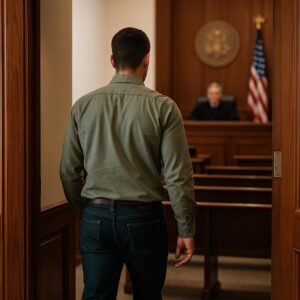The Oscar-nominated movie 12 Angry Men takes place in a single room in which twelve jurors hash out the fate of a young man on trial for murder. If you’ve seen the movie, you know how it ends, but if you haven’t, this article intends to help you understand “reasonable doubt.”
In the criminal court system, a jury must decide whether a person is guilty or not, and it must be sure about this decision. The prosecutor’s evidence and arguments need to prove that the defendant’s guilt is “beyond a reasonable doubt,” and the jury has to convict them. In modern-day courtrooms, this unspoken rule is in place to protect an innocent person from conviction.
We’ll talk more about how defense teams can create reasonable doubt and give some examples to help you understand this safeguard of the U.S. justice system.
What is Reasonable Doubt?
The definition of reasonable doubt is “the standard of proof that must be exceeded to secure a conviction in a criminal case.” Legal minds have debated the standard for centuries, going back to Aristotle’s work Problemata. We’ll talk about that later in the article, but the fact that it has been discussed for so long proves why it’s so important to try to understand it.
The jury of reasonable people must have no question of the person’s guilt due to the evidence presented by the prosecution. The jury must believe that the defendant is guilty; they cannot just think that they are. Reasonable doubt is the highest standard of proof because a conviction costs the accused person liberty or life.
Civil Cases
Civil cases are disputes where individuals argue their legal responsibilities to each other, as opposed to “crimes against the state” which are the criminal cases. Civil cases also have a burden of proof to achieve, but it is far less rigid than in a criminal courtroom.
In a civil case, the outcomes involve monetary damages and court orders, or injunctions, to force a person to fulfill their responsibilities. Because these punishments do not affect a person’s life or liberty, a “preponderance of evidence” is the standard by which civil cases are judged. A preponderance of the evidence by the plaintiff requires them to prove that there is more than a 50 percent chance that the defendant is in the wrong.
Plaintiffs in civil cases use physical evidence and testimonial to prove their cases. If they do not have a preponderance of evidence, then the defendant does nothing and wins.
The History of Reasonable Doubt
We mentioned Aristotle earlier; he was not the only early Roman concerned with the ethics of convicting an innocent person of a crime. A series of books under Emperor Justinian contain early legal theory as well. One passage in the Roman Digesta says to lean toward benevolence in legal matters: favor the defendant over the plaintiff when in doubt.
Skipping to fifteenth-century England, the role of the jury had become that of a listening body that assessed the evidence presented in the courtroom. Over the next three hundred years, legislators made simpler rules of evidence and the reasonable doubt standard. Legal philosophy moved away from faith-based arguments and toward logic and reason in legal cases.
Fast-forward to the Boston Massacre in 1770. Some scholars think that the term reasonable doubt first appeared during this trial. What was not in doubt was the hatred that the public had for these British soldiers. John Adams defended these men, and his closing arguments reminded the jury that “if you doubt the prisoner’s guilt, never declare him guilty.”
All but two of the soldiers and their captain were acquitted.
A Modern Example
The U.S. Supreme Court deems that the reasonable doubt standard of proof exists because it is “far worse to convict an innocent man than let a guilty man go free.”
This rule did not go unused in the 1995 O.J. Simpson trial. Although the burden of proof lies with the prosecution, the defense can attempt to sow doubt in the minds of the jurors as a counteractive measure.
Simpson was facing a large amount of evidence against him, including DNA at the crime scene, eyewitnesses, and blood in his car. His defense team came up with fifteen points of doubt that they presented to the jury, mostly attempting to suggest that O.J. was framed and that the officers involved were not honest.
The iconic scene of Simpson trying on the “bloody glove” to show that it didn’t fit his hand hammered home enough doubt for the jury to acquit him in criminal court. In a later civil trial, however, the preponderance of evidence was enough to prove him liable for the deaths and responsible for millions of dollars in damages.
What to Do If You’re Charged
Not everyone is as lucky as Mr. Simpson. He as able to hire a team of the best lawyers in the country, and they did for him what they were paid to do. However, even for a defendant without O.J.s resources, the idea of reasonable doubt applies to everyone.
If you are facing criminal charges, you must get legal help. Prosecutors must make the jury 99 percent sure that you committed the crime that you are charged with. Jurors cannot ever be 100 percent but they need to be very close. Even 75 percent isn’t going to bring a conviction.
Be aware of the penalties for the crime you are charged with. Here is a list of crimes and misdemeanors in Texas, and their possible fines and jail times. Contact us if you need a criminal defense lawyer. We believe that it’s a crime to convict an innocent person.





